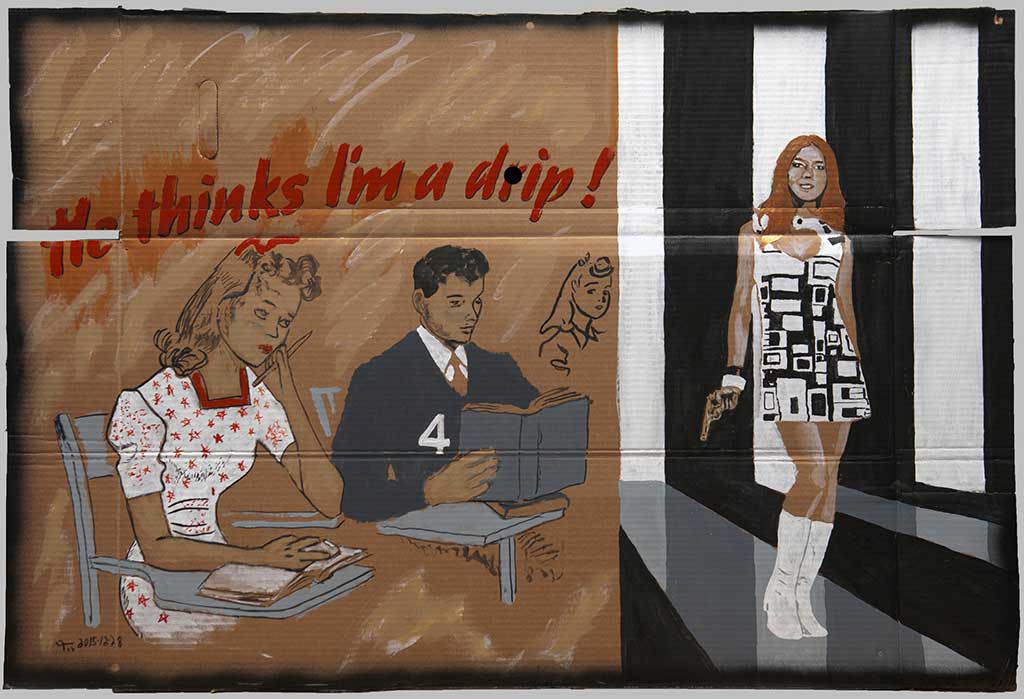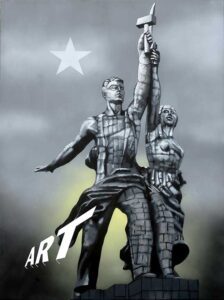

I offered MOMUS editor Sky Goodden first crack at publishing this critique of her own journal. My argument was that she’d raise MOMUS above the fray by enabling an uncomfortable discussion on the vulnerability of art magazines. The same concept was offered to Canadian Art magazine. Both discretely demurred. (3 years later, in 2021, Canadian Art suspends publication after an 83 year run).
MOMUS promotes itself as a return to art criticism, prompting two question; what kind of criticism and how good is it? MOMUS replies their writers are risk-takers, art historians, popular voices, and truth-seekers. Surprised, I asked where does MOMUS get such outlandish notions? Is it from envy at reading my own articles? Risk takers? (cough, cough.) Truth-seekers? Perhaps scribes who flourish jargon in exchange for a writer’s feedbag. (Disclosure; editor Sky Gooden has consistently rejected my articles, but I’m sure this one will earn her admiration.)
Robert Storr cuts to the chase with “a class of critics and artists that lost all sight of the reader and created a cult of difficulty based on jargon – the words used like pieces in an erector set to reference their own theories to other theories rather than to works of art.”(1) So with MOMUS, whose articles elicit admiration for arcane language but do they touch on topics meaningful? We read how Baselitz was sexist, surely a revolutionary exposé… ah, isn’t this news 20 years old?
What criticism, when you’re friend with everyone? Can’t criticize without ruffling feathers. How can you expose insider-trading or bad curatorial choices when that curator’s friendship is important to you? MOMUS overleaps these hurdles with lavish self-praise, and by attending global conferences where editors award each other certificates of significant achievement.
MOMUS is excellent at networking. “Informing the art world’s global economy and increasing professionalization, the artist residency has risen to the top, becoming one of the key features of contemporary art practice.” Art critic and publisher Sky Goodden hosts a Podcast conversation on this phenomenon, featuring international curators, critics, artists, and residency directors.(2) But when art is anything you can get away with, the worst you can get away with is always the best strategy, leading to a consistent degradation while the marketing stays ebullient.
“The concentration of power at the top of large-scale societies gives the elite a vested interest in the status quo;
they continue to prosper in darkening times long after the environment and general populace begin to suffer.” (3)
MOMUS is no worse than the best. I read Artforum at 15 and went facepalm at the consistent lack of relevance. I don’t want to hurt anyone’s feelings but the portico fails and civic warnings must be posted. Art rags love superficial jargon while ignoring their own fingers in the pie, or the gossip in the curator network, how these affects what and who we see in the gallery. For some reason we never read about the power of influence and insider trading.
The New York Times just hired editor Sarah Jeong, who writes how she hates old white men and loves insulting them, so we won’t expect to see old white men in the arts pages of the New York Times. Sarah justifies her racism by pointing to a long history of white racism, but she forgets the equally long history of Korean racism, so bad it has a chapter of it’s own in Wikipedia. Thin edge of the wedge; the Times just published Alice Walker’s admiring shout out of David Icke’s anti-semitic “exposé”, on how jews control global finances. I cancelled my subscription. You do not fight racism by being a worse racist. We want less racism, not more. Some say politicizing art was always a thing. It was bad luck then and it’s bad luck today; we want less corruption, not more.
Then came a moment of hope. At MOMUS podcast Episode 3, on criticism and journalism, Catherine G. Wagley (a Momus contributing editor, and a critic for ARTNews and The Los Angeles Review of Books, among others) wondered if the Halperin kind of reporting (on the 5 main U.S. galleries and their link with major institutions) isn’t also the province of criticism, as these politics affect what we see – and how. Sigh! The question raised in a hushed voice with a finger pointing far, far away.
Plenty to see at home. Is MOMUS returning to art criticism? Is Canadian Art magazine neglecting it? Canadian Art magazine plays coy at being PC. One article by Leah Sandals denounced a police raid on an amateur art gallery and after-hours speakeasy, that was important to the community because POC youth felt welcome there. I myself was surprised, shocked the police would raid an unlicensed after-hours club that sold alcohol to underage youth. Nice way to disturb the community, Ms. and Mr. Police officer!
The article, claiming to speak for the art community, questioned why police Tasered the bar co-owner, a skinny kid weighing less than 120lbs. A curator (the show curator?) said she had been in many police checks at illegal clubs but had never been treated so mean. I wonder if the skinny tried to assault a muscle-bound police lady while hysterically screaming “existential bias”? I imagine the cop laughing, which inflames the kid’s rage, so regrettably the Taser was sent for. “Existential bias”?
Perhaps it’s not the first Canadian Art story to sound biased. In the Disclosure Dictionary, the word “woke” also means “holier than thou” and “cherry pick your history”. Unverified assertions and “alternate truths” give the impression some editors ignore due diligence, and likely those interviewed laugh at gullible writers who believe everything they’re told. More juicy bits from this and other articles must be left veiled for lack of time. Canadian Art magazine could be suffering from Stockholm syndrome, believing the unfairly oppressed yet morally superior street kids and the local poor would never tell a lie. It looks like some writers allow their sources to hijack the story.(4)
Another Canadian Art story, now backed by a Canada Council research paper, told a tale I do not understand, perhaps for lack of advanced math skills. The article said, did I read this correctly(?), that 80% of people working in the Canadian cultural sector were female, yet the 20% who were male got 80% of the money, a narrative that confirms our views of male privilege. The author did mention there was a bias in the survey (for the sake of clarity) , recalling the four accountants who applied for a job and the one hired was the one who asked, “What do you want the answer to be”?
Since Canadian culture is funded by the Canada Council, which has strict gender equity laws, we’re amazed the Canadian cultural sector can be so sexist in favor of men; this is illegal, unfair, yet they get away with it. Oh that male privilege! Sheesh!
Even more bizarre, women in the arts are seriously political, yet they don’t mind gender pay disparity. In fact women are so nurturing and generous, they forgive this sexist distribution of cash… but it all sounds rather suspicious! Many strange stories abound in Canadian Art. Are they filling their pages with hyperbole, exaggerations not meant to be taken seriously? Or are these published straight faced? This journal gives the impression of bending fishy facts to fit politically correct waters. Canadian Art Magazine tries for the moral high ground… but if one fibs to get there it tarnishes one’s celestial wings and halo.
Derrida’s method of deconstruction was to look past the irony and ambiguity to the layer that genuinely threatens to collapse that system. One such layer is our forgiveness and tolerance of our friends’ worst duplicity along with being deaf to those who speak truth to power. Derrida would have laughed to learn that today’s art journals toe the line. It follows that creative territory gets submerged in orthodoxy; you can’t lead the pack if you follow.
Most fine arts producers graduate from similar schools sharing the same values, reflected in their association, production, and the systems created thereby; surely a cultural blind spot follows this homogeneity?
Still, who’d criticize art rags considering their clout? Which means till now there’s been no genuine art criticism in Canada, no risk-takers, no popular voices, not even truth-seekers. Few dare provoke the powerful, but as mentioned above, in a corrupt scenario a person who wants nothing is literally invincible; there comes a time when we must put gain or loss aside for a higher truth. Now you can see how the waters around you have grown, and you better start swimming or you’ll sink like a stone, for the times they are a changing.
Epilogue April 2022. Canadian Art stopped publishing in 2021 after a 78 year history. I wrote the obituary.
Miklos Legrady, Toronto Editor www.legrady.com
Endnotes
1-Stuart ServetarTHE INSPEAK OF THE OVERLORDS,N.Y.Press. May 29-June 4, 1996.
http://www.studiocleo.com/cauldron/volume3/confluence/miklos_legrady/text/storr.html
2- Sky Gooden, The Artist Residency, Dec. MOMUS 2017, http://momus.ca/episode-2-artist-residency/
3- Ronald Wright, A Short History of Progress,p109, 2004, CBC Massey Lectures.
4- http://canadianart.ca/news/community-concerned-after-toronto-gallery-co-owner-tasered-by-police/

